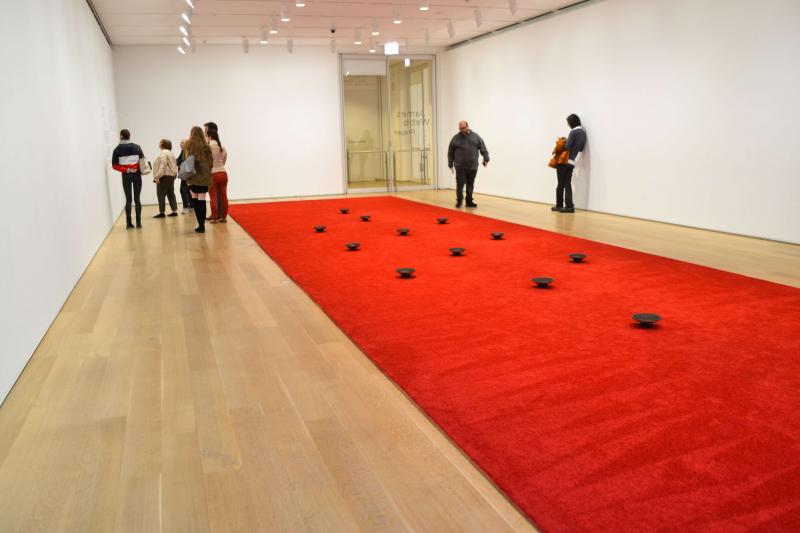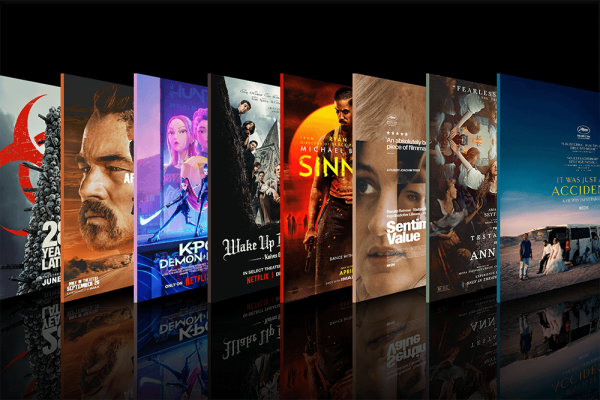Prayer in its purest form can be a precious thing — the whole of human longing boiled down to a cherished hope, a desperate plea, or a grateful psalm. In “Prayer,” a sound installation by South African artist James Webb, the uniqueness of prayer is inverted. Each faith community, from Bahá’í to Indigenous, melts into a noisy din.
At the Art Institute of Chicago, Webb has fit the sound of Chicago’s religious devotion into one room. The city’s religious life spouts from speakers fixed to the floor. Museumgoers shuffle across the expanse of red carpet, pausing over one mushroom shaped speaker and then another — like bees gathering pollen, intent on producing cultural understanding and greater empathy.
Webb created the first iteration of “Prayer” in Cape Town in 2000 as a response to his home country’s fractured post-apartheid state. He has installed nine “Prayers” since then in places including the United Kingdom and Sweden. Each version follows the same formula: Prayers from local religious groups, a red carpet, and tides of sound. The Chicago installation, like its predecessors, is simple in aim and elegant in construction. Though it is far broader in scope — around 250 people participated in the recording process, the most so far.
Listeners are free to engage as they wish, but many find the best posture is kneeling on the floor with one ear poised over a voice. It’s a familiar pose of supplication and a clear metaphor: Participants appear to pray as they absorb the prayers of others.
A polite sign asks me to remove my shoes before I step onto the carpet.
Out of the melee of sounds, voices emerge …
“Life itself is communion with the divine.”
“You are welcome just as you are. There are no conditions here.”
“O Lord, have mercy.”
prayer_in_text_tny.jpg

It has been my experience, that prayer is neither simple nor elegant. The beauty that exists is derived from its history — the idea that faithful people have been praying the same prayer for generations. Under the guise of what the Art Institute has mistakenly called “minimalism,” Webb has created an environment where prayers have been plucked from their context.
Minimalism, the art movement of the 1960s, reduces an element to its most basic components. The visual result of the subtraction is rudimentary. People struggle with minimalism for this reason, seeing it as an art form built around shortcuts. When looking at the work of an artist like Ellsworth Kelly, it’s not difficult to see why. Kelly’s paintings explore color and shape by using a severely reduced color palette and amorphous forms.
Kelly was fundamentally interested in the essence of things. Like Webb’s audio, Kelly’s paintings and drawings function as Rorschach tests. With Webb and Kelly, people hear what they like and see what they like, respectively. Here though, is an important difference: Kelly’s shapes are an oasis for the eyes and stand proudly against the extravagance of contemporary visual culture. “Prayer,” for all its ambition, offers no respite.
In the exhibition, voice serves as a proxy for cultural heritage, religious rites, and the people who perform them. Unfortunately, religion is not composed solely of sound and fury. Religion is also about what people do. Tying to reduce the entire scope of a ritual or tradition is difficult, if not nearly impossible.
Dutch sculptor Folkert de Jong said, “Reduction and silence in times of chaos gives people time to breathe and think about what is essential.” At the time, he was referring to artists like Constantin Brancusi and Hans Arp, who built spare, almost skeletal sculptures amidst the horrors of World War I. De Jong couldn’t understand why Arp and Brancusi wouldn’t subscribe to overtly political forms of art making until he realized that the simple sculptures were the response.
Unfortunately, Webb offers no such relief from the chaos. There is no reprieve from constant motion and sound. I hear someone invoke “the ancient name of God” before my attention is pulled elsewhere.
Each faith community that participated received a copy of their recording. But why not place the recording in its corresponding house of worship and show a visual of it playing there? Some prayers are not in English. Could a translation be provided? Many prayers are in English. Could translations in other languages be provided? At the very least, a map explaining where to find the prayers of each tradition would help to reconfigure the space as a place where religious beliefs are honored and not simply conflated.
Perhaps Webb could play just one voice at a time instead of releasing a flood of sound. But it seems the last alteration would expose something this exhibit is trying very hard to cover up — that wanting the same things from God doesn’t change the fact that people have very different ideas of who God might be. Far from intimidating, this gap is what makes interfaith dialogue so rich — similarity and difference go hand in hand.
Ultimately, Webb’s project reads more as a sociological experiment than a metaphysical one. For the sterile sanctuary that is the Art Institute, sociology is a noble enough goal. However, if moral relativism could make us kinder, we would already be so.
As I write this, almost a week after the election and a few days after yet another mass shooting, inundated with news media, I wonder if what we need is less an aural collage and more a carefully curated celebration of difference. More silence, less noise. It is a more complicated endeavor, but I suspect Webb, should his interests ever run in that direction, is more than up to the task.
For all the perceived missed opportunity and cacophony, there’s nothing quite like kneeling in a field of prayers.
“Prayer” is on exhibit at the Art Institute of Chicago until December 31, 2018.
Got something to say about what you're reading? We value your feedback!







